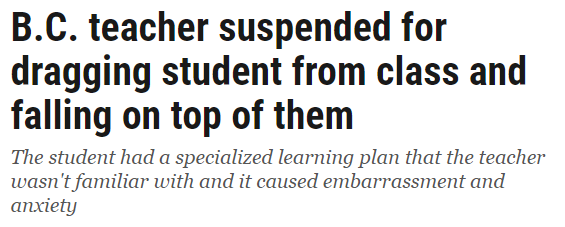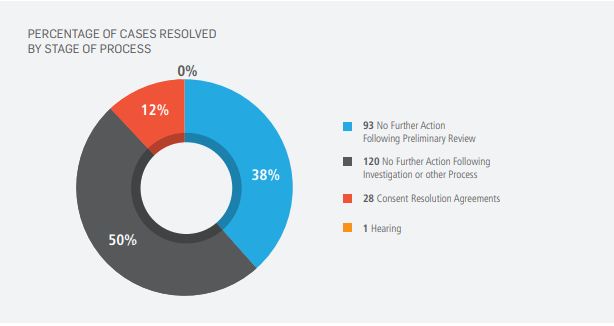IEP’s can play an important role in providing your child an equitable education. They are important.
We have law, policy and teachers’ standards on our side.
As written in the human rights decision P (by KD) v. Board of Education of School District No. 61 (Greater Victoria) and another, 2025 BCHRT 62 the Ministry of Education made it clear:
[70] …..The Ministry says IEPs do have a legal effect and function, as there is a valid legislative and policy framework that provides both authority and guidance for IEPs.
For more information about how the Ministry views IEPs in terms of a written contract or requiring a parent signature, please read paragraphs 66 – 71 in the above human rights decision.
So what do they mean by valid legislative and policy framework?
Authority School Act, Section 182 (2) (a)
On the Ministry of Education’s Inclusive Education website they say this:
“School Districts/Independent School Authorities have the autonomy to develop their own IEP template or choose the SMART Goal Template, or Competency Based IEP Template found on MyEducation BC. Specific templates are not mandated as long as the goals used have measurable outcomes.”
The Ministry of Education has an Inclusive Education Manual (2024), and section C is all about developing an IEP
Here is the Ministry’s Guidelines on IEPs for independent schools
Here is the Inclusive Educaiton list of policies and orders
If you are interested, here is a list of all of the School Act Ministerial Orders.
Here is a list of their policies for public schools.
On your own school district’s website, they will also have information about IEP’s and the consultation process.
Here are two excellent resources on information about IEPs and IEP meetings.
The BCCPAC has a guide for parents specifically for IEPs
Inclusion BC has a guide for Inclusive Education. Chapter 5 is all about IEPS.
Two notable human rights cases:
- The duty to consult
- Student (by Parent) v. School District 2023, BCHRT 237 – Your child doesn’t need to have an IEP in order for them to be protected by the Human Rights Code
Something else very important to keep in mind is that the Human Rights Code Supersedes classroom teacher autonomy. Your child’s teacher has to follow the Human Rights Code.
IEP’s are working documents.
The final decision is up to the school on what is written on your child’s IEP but they must consult with you. And it needs to be meaningful consultation. If they tell you they are only giving you 30 minutes for an IEP meeting and you didn’t have enough time to discuss everything and you feel in the IEP isn’t appropriate for your child, you can advocate that 30 min isn’t enough time for meaningful consultation. Some parents get letters being sent home that IEP meetings aren’t even happening. They get a paper copy and they are asked to provide feedback by email. umm. NO!!! If you want a meeting to discuss your child’s IEP at ANYTIME In the year, you can advocate for that.
If the school doesn’t allow this, then you can escalate it through the district and just keep going higher and higher.
The IEP is a working document.
For this human rights case X by Y v. School Distrct Z 2024 BCHRT 24, the expectation for them to defend that they offered reasonable accommodations is this:
120] Ultimately, on a balance of probabilities, I am satisfied that the District discharged its duty to accommodate X in his grade 2 year by reviewing the Diagnosis Report, developing an IEP, making various support people and strategies available that were incorporated into the classroom and outside, reviewing progress and changes, and adapting its approach in response……
If they aren’t reviewing progress and changes and adapting their response to your child’s needs, you have internal and external complaint options.
There is already legislation, policy and human rights law that will enforce consultation. You can use these in your advocacy.
It is very important to keep documentation of all of your emails with the school and letters being sent home. If you are getting any communication that parents are not allowed to attend their child’s IEP meeting, you may also want to alert the Inclusive Education department in the Ministry.
IEPs have meaning. They are important. They are a tool.
If you have a teacher who is refusing to follow any of the legislative framework and policies you can always file a TRB complaint.
This teacher was disciplined for the following regarding IEPs:
During the 2021-2022 school year, the following events occurred while Schwarz was employed as a teacher in a learning support program at School A, working with a small group of upper elementary school students (“Class A”):
a. Schwarz failed to properly follow procedures for students’ individual education plans
(“IEPs”):
i. IEPs must be reviewed annually to reflect individualized goals, adaptations,
modifications, services and measures for tracking progress. Teachers must
offer parents an opportunity to consult about their child’s IEP.
ii. Schwarz failed to plan appropriately for the fall 2021 IEP deadlines and
only updated the students’ pictures and changed the name of the responsible
teacher to her own name, before submitting the IEPs to the School principal.
Schwarz did not make changes to the substance of her students’ IEPs and
did not appropriately consult with parents regarding the IEPs.
You don’t need to accept teachers not consulting with you or not updating your child’s IEP.
You have advocacy options:
Internal – keep advocating all the way up the next levels. You will have an inclusive education department in your child’s school district. Inclusive BC in their manual, Chapter 7 is all about how to advocate in the education system effectively.
External – TRB, Ombudsperson, Human Rights Tribunal
Some schools automatically reach out in the spring for a review of the IEP. If your child’s school does not, and you would like this to happen, feel free to send them an email.
You also don’t need to wait for the spring. If at any point in the year, you feel there needs to be some changes, you can request a meeting.
Your child has a human right for an equitable education. The IEP is a very important tool that can help them have those accommodations in place. OH, and one final thing. Accommodations are not earned with good behaviour. Children with disabilities have a right to their accommodations because they are breathing.



